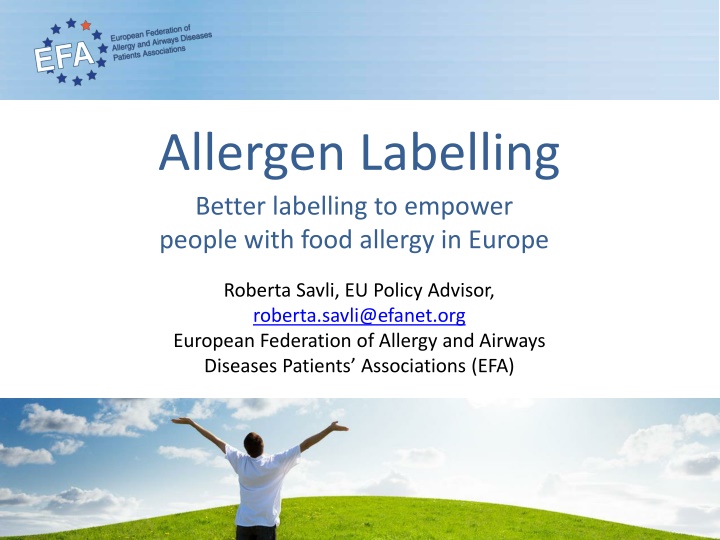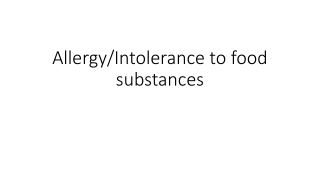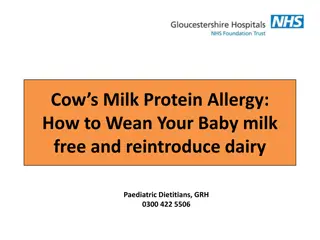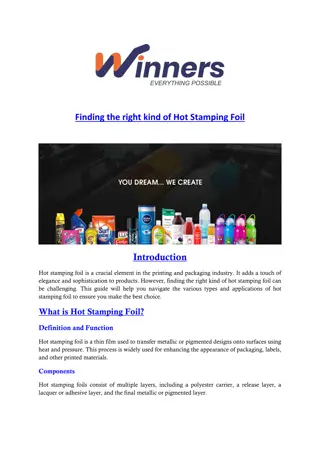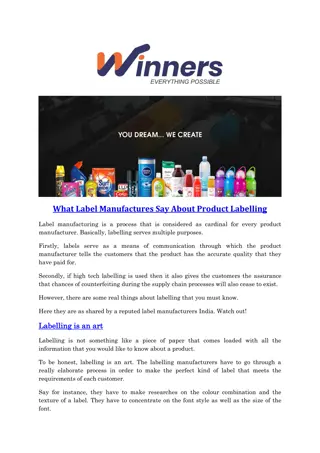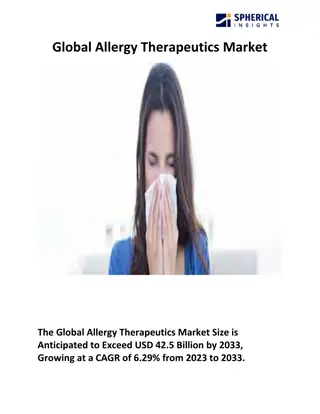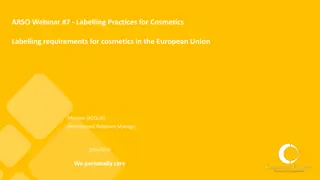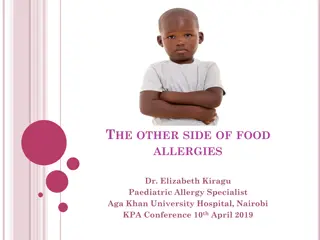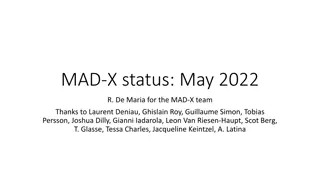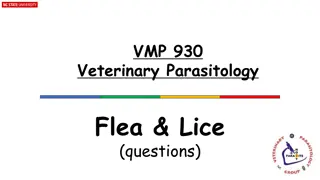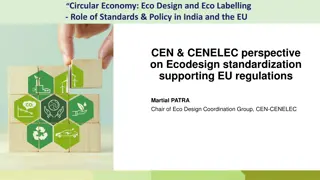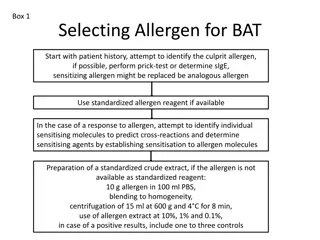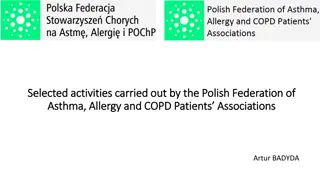Enhancing Food Allergy Awareness Through Improved Allergen Labelling in Europe
The European Federation of Allergy and Airways Diseases Patients Associations (EFA) emphasizes the significance of accurate allergen labelling to empower individuals with food allergies. With up to 25% of the European population affected by food allergies, the need for clear and accessible information is critical. Issues such as inadequate information, small font size, cross-contamination risks, and changes in food composition pose challenges. The EU Regulation No. 1169/2011 aims to address these concerns and enhance consumer safety and well-being.
Download Presentation

Please find below an Image/Link to download the presentation.
The content on the website is provided AS IS for your information and personal use only. It may not be sold, licensed, or shared on other websites without obtaining consent from the author.If you encounter any issues during the download, it is possible that the publisher has removed the file from their server.
You are allowed to download the files provided on this website for personal or commercial use, subject to the condition that they are used lawfully. All files are the property of their respective owners.
The content on the website is provided AS IS for your information and personal use only. It may not be sold, licensed, or shared on other websites without obtaining consent from the author.
E N D
Presentation Transcript
Allergen Labelling Better labelling to empower people with food allergy in Europe Roberta Savli, EU Policy Advisor, roberta.savli@efanet.org European Federation of Allergy and Airways Diseases Patients Associations (EFA)
Who is EFA? The European Federation of Allergy and Airways Diseases Patients Associations (EFA) is an independent non- profit European alliance of 38 allergy, asthma and chronic obstructive pulmonary disease (COPD) patients associations representing 30% of European citizens currently living with these diseases.
Food allergy across Europe Up to 25% of European population reacts to food (allergy, hypersensitivity, intolerance) About 17 million Europeans suffer from food allergies, with 3.5 million of them less than 25 years of age Over the past ten years, the number of allergic children younger than 5 years has redoubled and the emergency room visits for reactions have increased seven-fold * anaphylactic * Source: http://bit.ly/ZfKNi9 (accessed on 09 September 2014)
Importance of allergens information Allergy is a crazy disease as the immune system of an allergic person fails to distinguish between dangerous substances and harmless ones BUT Allergies can make you crazy too! as they might result in poor nutrition and quality of life, fear, restrictions, social isolation, and sometimes even death (anaphylaxis) No cure for food allergy Protection = abstention Consumers suffering from allergy or intolerance must therefore be able to identify the ingredients they are sensitive to
Main issues with food labelling Information simply not available or inaccurate Readability too small font, poor contrast Cross-contamination, precautionary trustworthy, no common practice, limitations to diet Changes in recipe and introduction of novel ingredients (lupine) new allergies Complicated and processed food containing unnecessary ingredients Not in national complicating travelling labelling not Regulation (EU) No 1169/2011 of the European Parliament and of the Council on the provision of food information to consumers, a positive step to improve health and quality of life of people with food allergy language
Allergens in pre-packed food Mandatory indication of substances or products causing allergies or intolerances or derived from them (listed in annex II of new regulation) Emphasising allergens within the ingredients list through a typeset that clearly distinguishes them from the rest of ingredients (novelty as of 13 December 2014) EFA request: bolding allergens, the best way to highlight them and attract allergic consumers attention Where no list of ingredients is required, label on the package with the wording it contains followed by the name of the allergen EFA request: ingredients list always compulsory (irrespective of the size of the pack and both for pre-packed and non pre-packed food) as many people may be allergic to other substances than those listed in annex II Labelling not required when the name of the food refers to the allergen Information on allergens also in case of food distance selling before the purchase is concluded BUT
List of allergens The new regulation maintains the same list of allergens, which can now be updated by Commission s delegated acts novelty (possibility for urgency procedure in cases of emerging risks to consumers health) State of play: EFSA draft scientific opinion on the evaluation of allergenic foods and food ingredients for labelling purposes, results of public consultation to be published, final opinion expected by end of 2014 EFA request: review of the list of 14 existing allergens on the basis of the most recent scientific knowledge Need for reviewing the prevalence of food allergy in Europe with the possibility of identifying emerging allergens Avoid precautionary approaches for novel foods entering the market (e.g.: rapeseed protein and possible allergenicity for people allergic to mustard) Threshold concentrations of each allergen in food providing an acceptable level of protection for consumers
Pictograms Implementing acts may be adopted by the Commission to express information by means of pictograms or symbols instead of words EFA request: allergens need to be properly mentioned always with their names, but the addition of pictograms can be positive for people travelling across Europe, need to have a harmonised set of pictograms Cereals containing gluten Nuts David, father of a severe allergic children: Whilst we are in our home country, food labelling is a daily activity to keep our son alive; but when we go overseas, things become a lot more difficult. Celery Crustaceans Mustard Eggs Sesame seeds Fish Sulphur dioxide Peanuts Lupin Soybeans Molluscs Milk
Allergens in non pre-packed food Member States can decide how the information on allergens should be made available to consumers and its form of expression and presentation for non pre-packed food (novelty as of 13 December 2014) 7 out of 10 severe reactions happen when people eat out * EFA request: Written information is the most reliable means of ensuring the provision of detailed information and clear recommendations to the allergic consumer, unless it is possible to talk directly to the person that prepared the food Sharing best practices among EU Member States legislations Drafting and implementing EU-wide guidelines * Source: http://bit.ly/1qGwAoT (accessed on 11 September 2014)
Eating safely best practices presented at EFA s event recommendations Call on Member States to: Regulate information on allergens for non pre-packed food in a written way possible flexibility when direct contact with person that has prepared the food Develop programmes on food allergen management for people working in the food service sector Label consumption units in pre-packed food Call on the Commission to: Follow-up to this event and share Member States best practices Drafting and implementing guidelines EU-wide
Precautionary labelling Member States may provide voluntary information on the unintentional presence of allergens, the Commission is required to set harmonised rule on the use of this voluntary information (implementing acts with no deadline) Serious reactions, and even deaths, have been caused by food with may contain labelling 8% of people with accidental reactions may attribute it to having ignored a precautionary labelling * EFA request: Long-term: abolishment (complete and accurate information, establishment of safe thresholds ) Short-term: possible to use only as ultimate solution after implementation of best-practices to avoid cross-contamination Allergen management as part of hygiene/safety manual Awareness and practical workplace training on food allergy for workers Responsibility of food business operators at each step of the distribution chain European guidelines on food allergen management * Source: Barnett J et al, Using may contain labelling to inform food choice: a qualitative study of nut allergic consumers, BMC Public Health 2011, 11, 734742
Patients views on may contain labels It reduces the choices available to allergic consumers Regardless of the label: may contain labelling for nuts is included on the packaging of 26% of biscuits and 80% of chocolate Reference: Van Hengel AJ, Declaration of allergens on the label of food products purchased on the European market, Trends Food Sci Tech 2007, 18, 96-100 It results in frustration and risk-taking behaviours, not depending on age, gender or the severity of the allergy Variety of the wording: 80% of parents with nuts allergic children would not let them eat products with not suitable for or may contain labelling, only 50% would do so with cannot guarantee nut free or may contain traces of labelling Distrustfulness sources Implausibility of the labelling Previous experience and personal preferences Reference: Barnett J et al, Using may contain labelling to inform food choice: a qualitative study consumers, BMC Public Health 2011, 11, 734742 THEREFORE Unnecessary restrictive diet: 90% of products with labelling do not contain residues of peanuts proteins or very small quantities unlikely to cause a clinical reaction Reference: Hefle SL et al, Consumer attitudes and risks associated with packaged foods having advisory labelling presence of peanuts, J Allergy Clin Immunol 2007, 120, 171-176 precautionary of the message regarding the of nut allergic
Patient-centred best practices Switzerland: Federal law on labelling and advertisement of food products: applying to pre-packed food and non pre-packed products (non-bindingness of the written form) Obligation to label allergens, even when they have been added involuntarily, upon specified levels Under these thresholds, precautionary labelling is only authorised if the responsible food business operator can prove that cross-contamination cannot be avoided United Kingdom: Voluntary Guidance on Allergen Management and Consumer Information Food Standards Agency Assess risk from both intentionaland unintentional presence of an allergen Check if the potential allergen is in the ingredient list or is exempt from mandatory labelling Identify the risk and the possibility to manage it Communicate the risk through precautionary labelling only if it cannot be managed Sweden: Voluntary Swedish Food Sector Guidelines for management and labelling of food products with reference to allergy and intolerance Swedish Food Retailers Federation and Swedish Food Federation May contain labelling as a last resort when the risk of cross-contamination is: Uncontrollable: the ability to ensure the entire process is considered impossible Sporadic: the allergen is detected sporadically after product changes Documented through cleaning controls, test results, or substantiated consumer reaction
Key points for improvement Readability Information on allergens should be provided in a font size equal to or greater than 1,2 mm; whereas in case of small packaging or containers (surface area less than 80 cm ), the minimum font size is reduced to 0,9 mm EFA request: minimum 3 mm font size to guarantee clear legibility and safe choices, comprehensive approach to take into account all aspects related to legibility, including font, colour and contrast Djoeke, mother of a severe allergic children: Reading labels should be peanut and it is not! need to develop a Changes of recipe Nothing changes/additions in products EFA request: if there is a change in a recipe that contains allergens, this should be clearly mentioned in the package or label as, even though the allergens are always labelled, the consumers may feel safe due to the previous consumption of the product and not check properly the list of ingredients is mentioned regarding labelling allergen
Thank you for your attention! European Federation of Allergy and Airways Diseases Patients' Associations (EFA) https://www.facebook.com/EFAPatients https://twitter.com/EFA_Patients 35 Rue du Congr s 1000 Brussels, Belgium www.efanet.org
